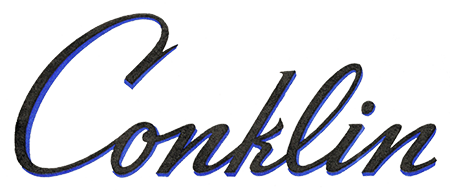Conklin Nozac V-Line 1937–38
by Jim Mamoulides, March 13, 2023
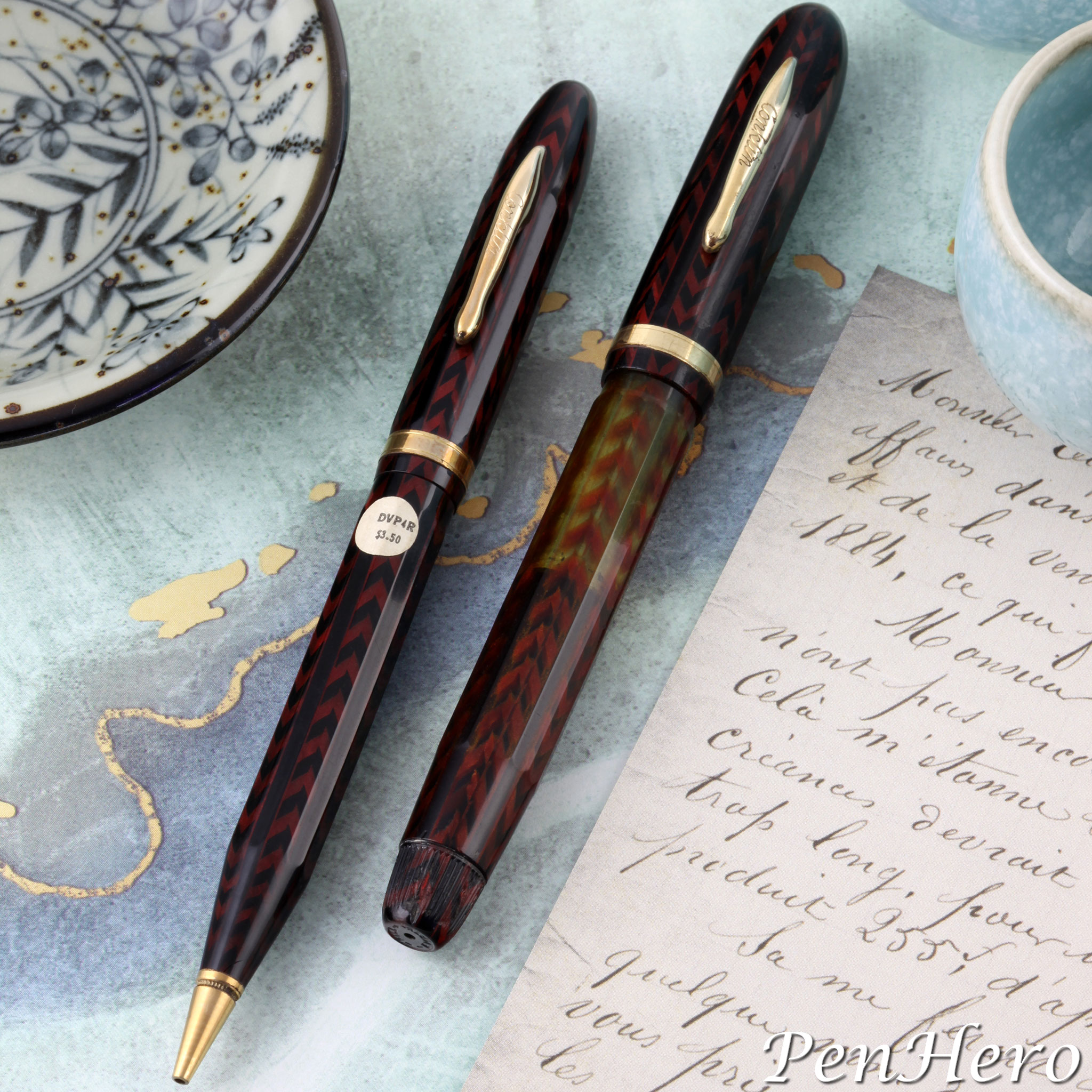 Conklin Nozac V-Line pen and pencil set in Burgundy c. 1937-38
Conklin Nozac V-Line pen and pencil set in Burgundy c. 1937-38
What is that herringbone pen?
When Conklin introduced the Chevron line in 1936, it came with a new celluloid that was design patented by Andreas Bienenstein on September 17, 1935. His two design patents show a representation of the cap and barrel of a pen opened and closed with a repeating pattern of rows of black and white chevrons separated by plain stripes with the chevron stripes running in opposite directions. Design patent D0968921 shows the stripes running the length of the cap and barrel and D0968902 shows the stripes running at a 45-degree angle around the cap and barrel. The resulting look of both the Chevron and V-Line pens has frequently prompted collectors to call them “herringbone.”
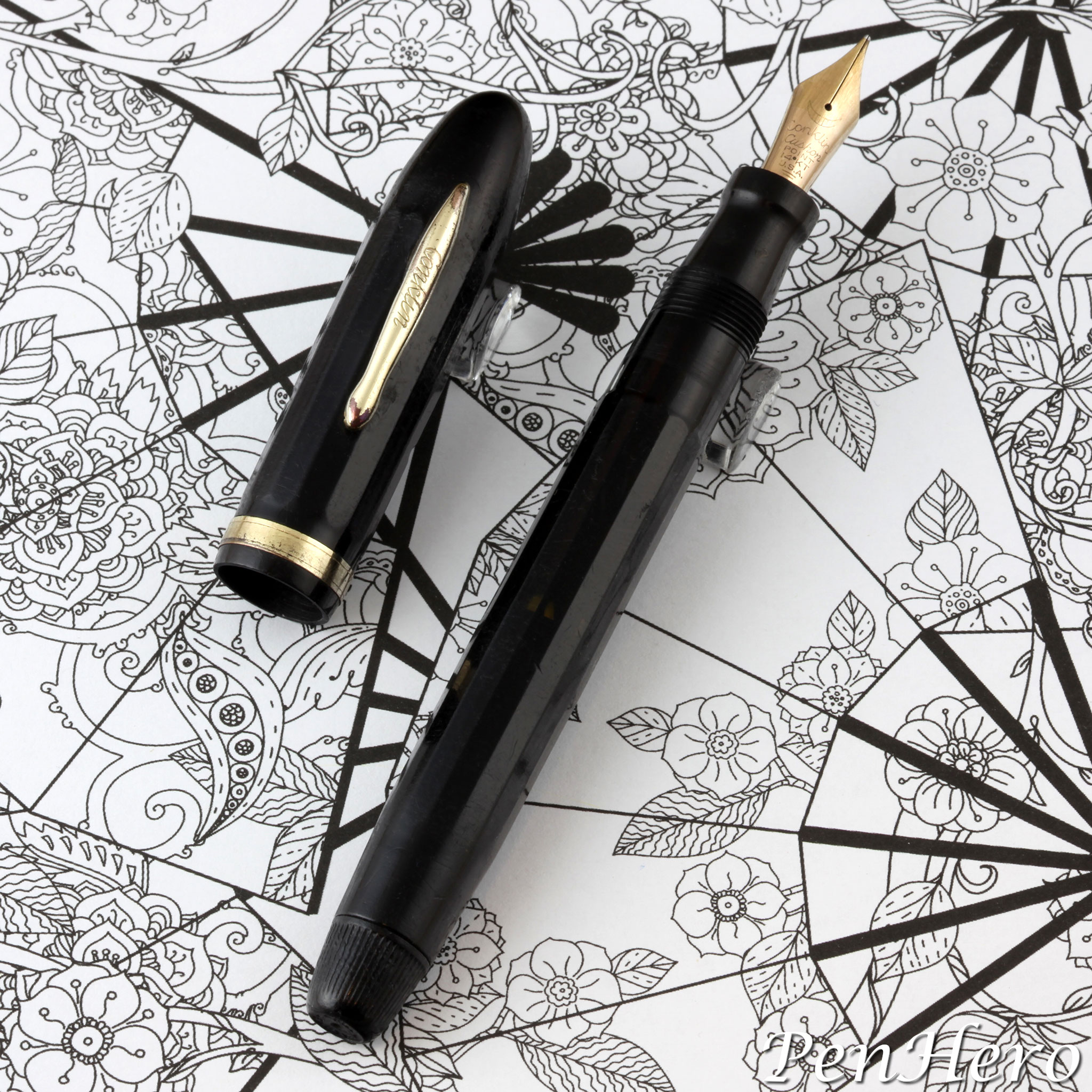 Conklin Nozac V-Line pen in Black c. 1937-38
Conklin Nozac V-Line pen in Black c. 1937-38
The V-Line Nozac line was introduced in 1937. The earliest known advertisement, in the September 11, 1937, Saturday Evening Post, calls it a new model. In many ways the V-Line is a less ornate version of the Chevron line. It uses a monochromatic version of the patented chevron celluloid pattern as opposed to the previous year’s bold Chevron celluloids. Conklin named the muted palette of colors Royal Blue, Burgundy, Pearl (grey), Black, and Nile Green. The fancy cap band was replaced by a plainer one, the same as on the second generation Penline, and the Word Gauge feature was dropped. Although the striped Penline went through a change in the celluloid design from marbled to brickwork, Conklin may have felt that the V-Line was sufficiently different to create a new name.
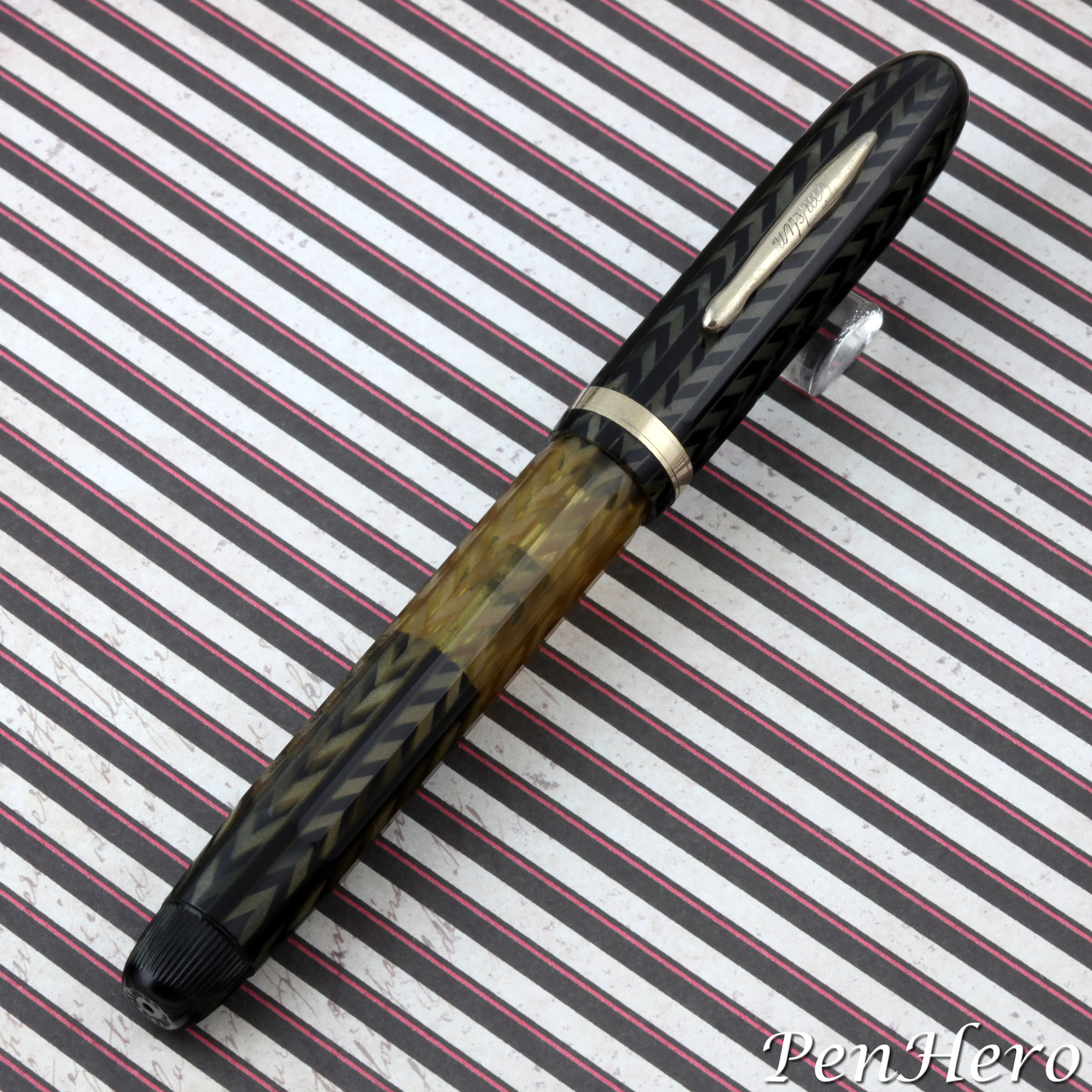 Conklin Nozac V-Line pen in Grey Pearl c. 1937-38
Conklin Nozac V-Line pen in Grey Pearl c. 1937-38
The full-size V-Line and Chevron pens are the same size, though there are more V-Line model variants. V-Lines were made in faceted and round shapes and continued the use of the 1936 patented Conklin clip and the Cushon Point nib. They were made as a 14-sided oversize model; a 12-sided standard model; a ladies’ long, round model; and a ladies’ short round model. The caps on the round ladies’ models are interchangeable; only the barrels differ in length. The oversize model is the same size as the earlier 7M word gauge models, including the Chevron line. Likewise the standard size model is the same size as the earlier 5M word gauge models, including the Chevron line.
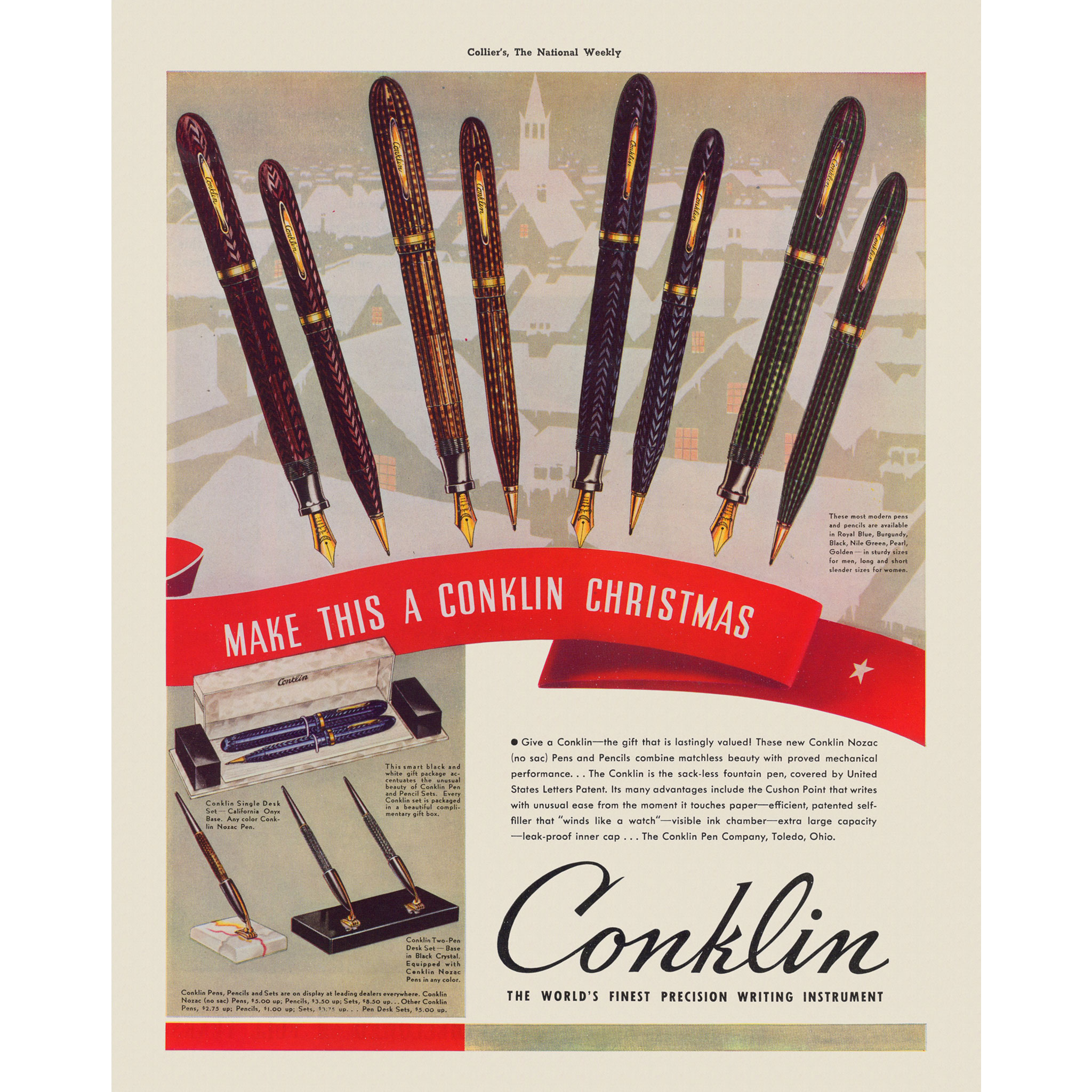 Advertisement in Collier's, December 11, 1937
Advertisement in Collier's, December 11, 1937
In December 1937, only a few months after the launch of the V-Line, newspaper advertisements appear offering the previous year’s Chevron models at deep discounts. By mid-1938, V-Line models are being discounted. A full-page June 15, 1938, Macy’s advertisement in the New York Daily News prominently features a V-Line model and tells the story that the store’s buyer flew to the Toledo factory and ordered 14,000 of the 1938 models to be sold at 60 percent off list price. All the V-Line colors are featured, though the advertisement refers to them as chevron design pens.
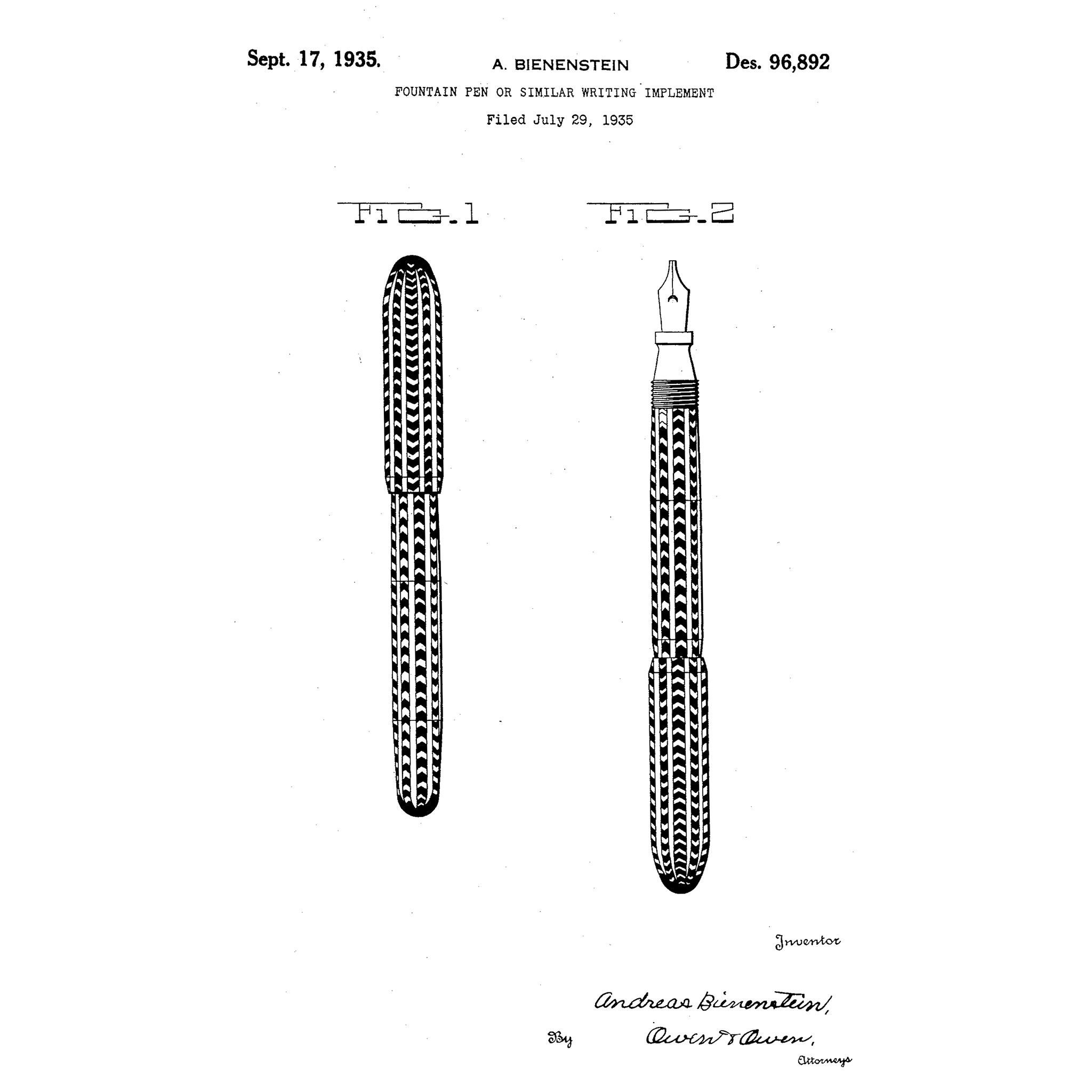 U.S. Design Patent No. D96892 awarded September 17, 1935 to Andreas Bienenstein
U.S. Design Patent No. D96892 awarded September 17, 1935 to Andreas Bienenstein
Signs of trouble at the Conklin Pen Company could be seen in 1937 with a sit down strike starting February 20, idling the company’s 115 workers until March 9. The company was sold to a Chicago syndicate consisting of A. J. Parrson, M. H. Jacobs, and Max Horwitz on July 13, 1938.
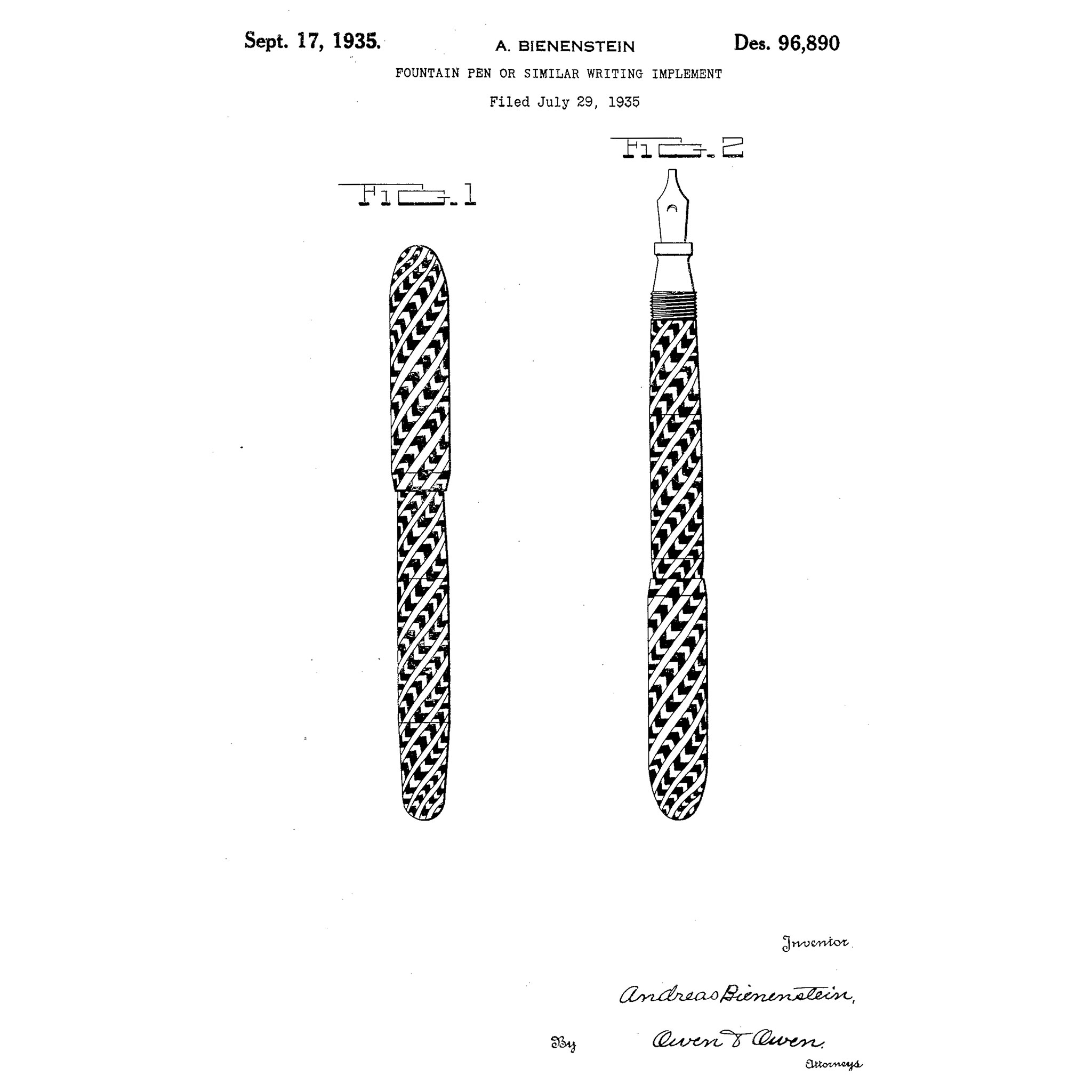 U.S. Design Patent No. D96890 awarded September 17, 1935 to Andreas Bienenstein
U.S. Design Patent No. D96890 awarded September 17, 1935 to Andreas Bienenstein
Identification Guide and Features
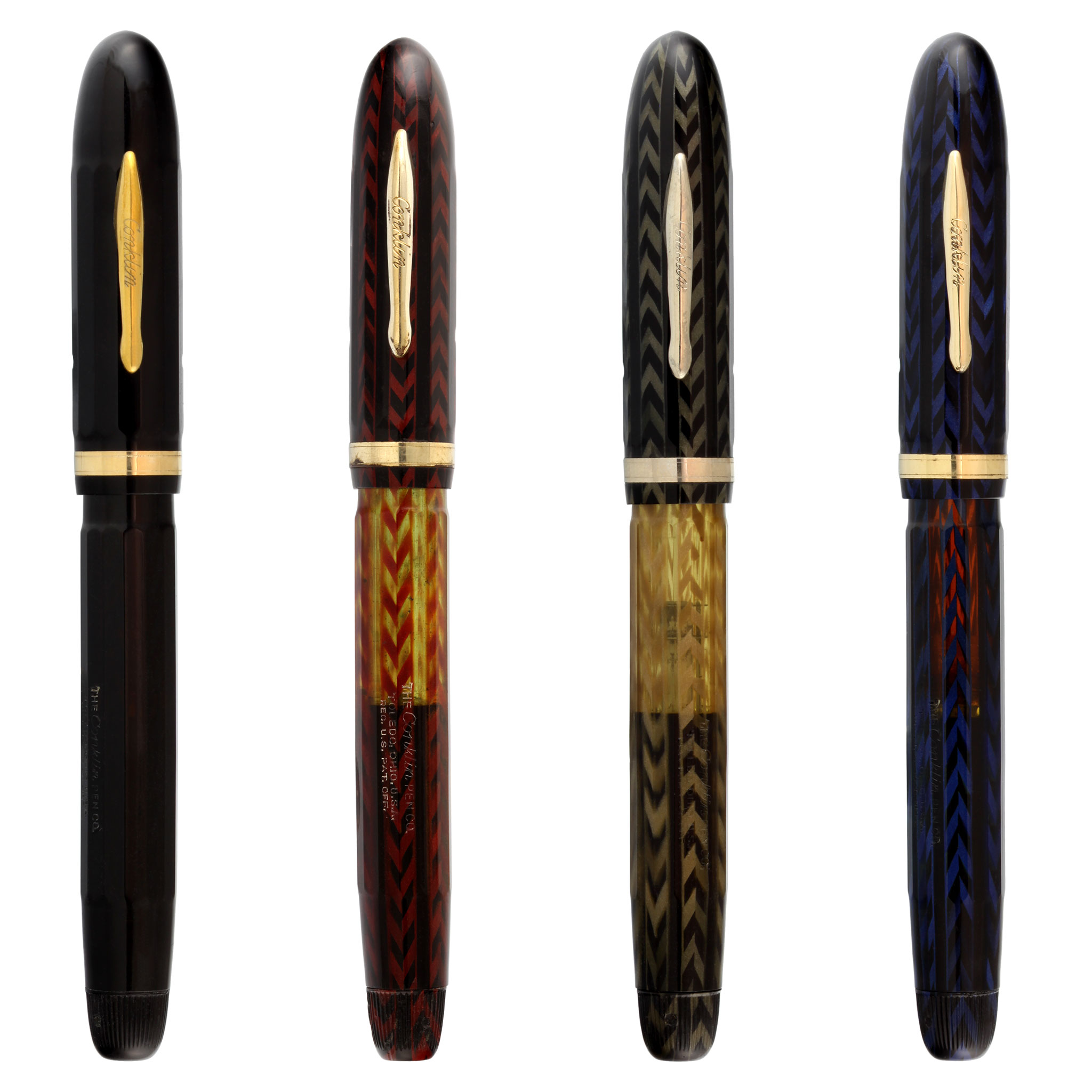 Conklin Nozac V-Line colors: Black, Burgundy, Nile Green, Royal Blue
Conklin Nozac V-Line colors: Black, Burgundy, Nile Green, Royal Blue
Catalogs and advertisements show V-Line models offered as in the list below. Conklin clearly made variations, as can be seen when many pens are examined. These may be due to custom orders, production design changes, or pens being made from available parts. The variations include pens found with two-tone platinum or palladium plated gold nibs, nib sections made from matching barrel celluloid, filler knobs made from matching barrel celluloid, and non-advertised cap bands. This list captures what’s common, cataloged, or advertised as Nozacs.
- Faceted or round celluloid cap and barrel made of chevron stripes separated by dark translucent stripes. Pattern alternates direction with each stripe
- Colors offered were Royal Blue (or Blue), Burgundy (Red), Pearl (Grey), Black, and Nile Green (Green)
- Four sizes: 14-sided oversize model (about 5 3/8 inches long), a 12-sided standard model (about 5 1/4 inches long), a ladies’ long round model (about 5 inches long), and a ladies’ short round model (about 4 5/16 inches long)
- Gold-filled clip and trim
- Plain cap band with an engraved line at the edges
- Conklin stamped 1936 patent clip
- Cap unscrews
- Black or barrel-color nib section
- Black or barrel-color piston knob
- 14 karat gold Cushon Point nib with Conklin Crescent logo
- Nib grades offered were extra-fine, fine, medium, coarse, medium stub, broad stub, left oblique, two way, and Recorder in extra-fine, fine, and medium
- Piston-filling mechanism
- Large faceted fountain pens sold for $7.50, slender faceted fountain pens sold for $5.00, long and short round fountain pens sold for $5.00, and matching twist-action pencils were $3.50.
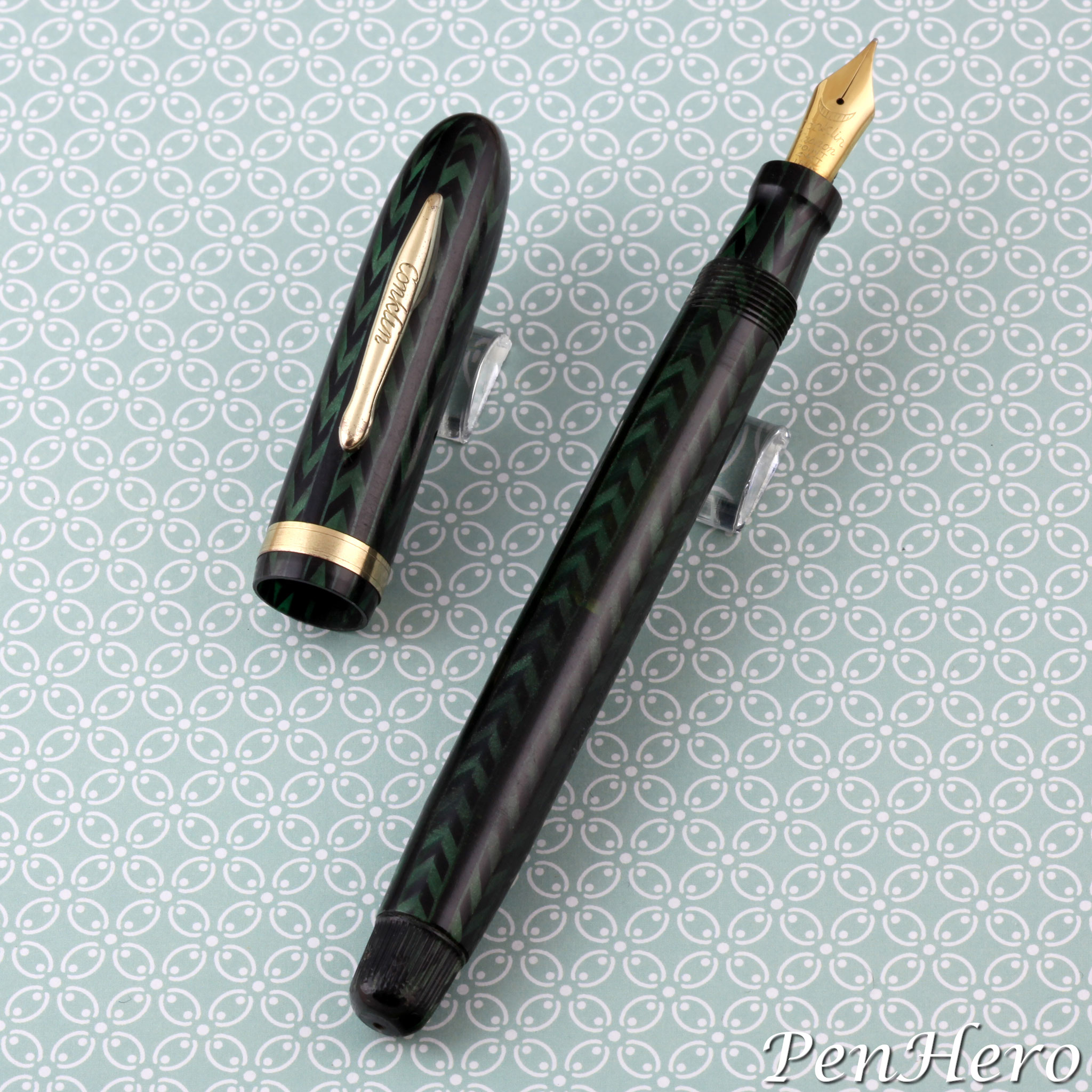 Conklin Nozac V-Line pen in Nile Green round c. 1937-38
Conklin Nozac V-Line pen in Nile Green round c. 1937-38
Performance
V-Line Nozacs are more muted than the Chevron pens that preceded them, but they stand out next to the many marbled and striped celluloids offered by other brands, especially the faceted pens. The pens to look for will have a clear ink chamber at the top of the barrel, the piston mechanism will turn freely and visibly advance and retract, and it will draw water without leaking. V-Line Nozacs are the same size as their Penline siblings at about 5 1/4 inches long capped and 6 1/8 inches posted. They will post reasonably securely on the end of the barrel, but not tightly enough for vigorous writing. I don't post these pens as I want to avoid encouraging cap cracks. The spring loaded clip, when it is in good condition, works like a clothespin where you press the top and slip the pen in your pocket. The pen will ride high but securely.
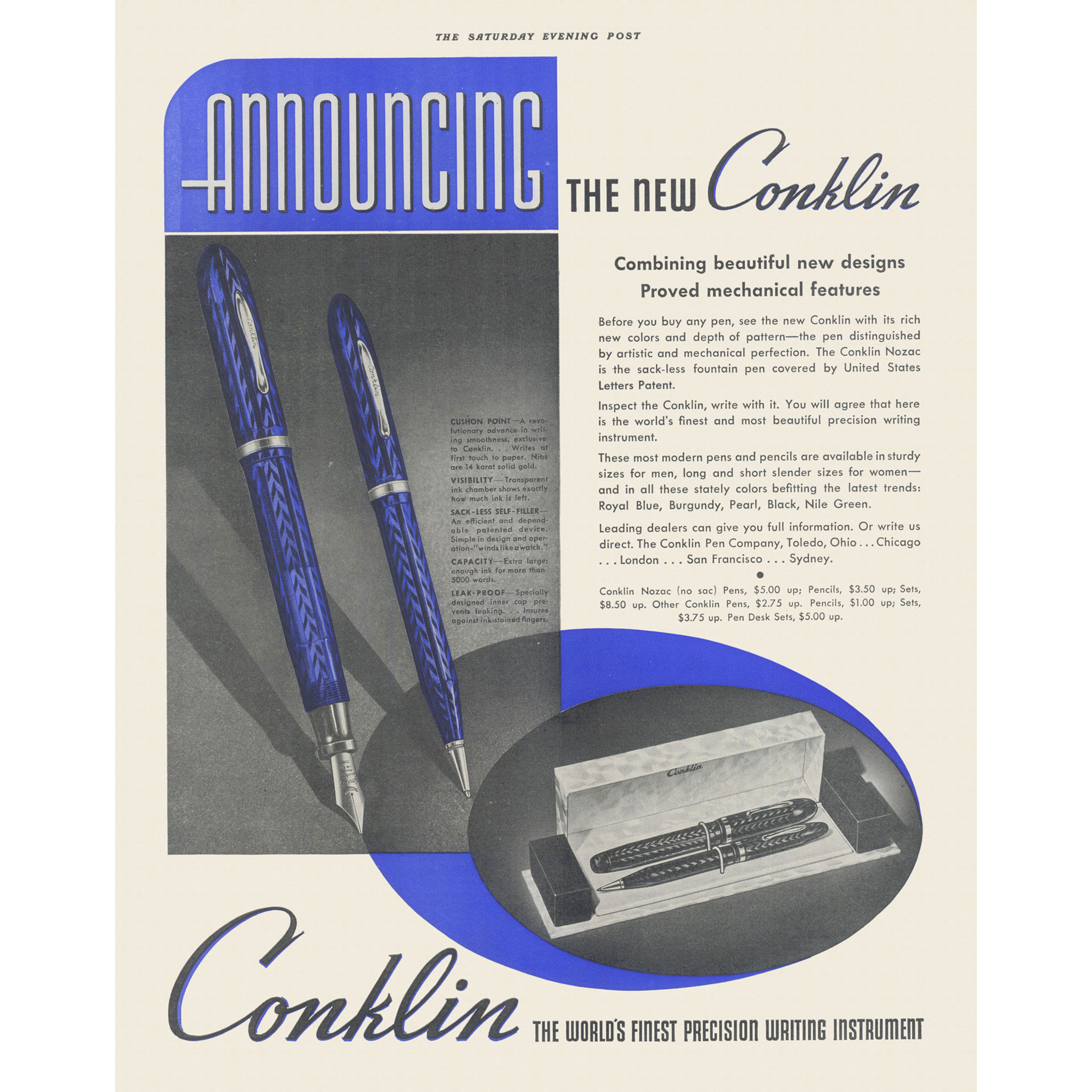 Advertisement in Saturday Evening Post, September 11, 1937, page 62
Advertisement in Saturday Evening Post, September 11, 1937, page 62
V-Line Nozacs fill by twisting the filler knob until the plunger is at the top of the barrel, dunking the nib into the inkwell, and twisting until the pen slowly sucks up the ink. If the top of the barrel clarity is good, there will be a very good indication of ink level. Conklin Cushon Point nibs can be very nice when properly tuned, and my tester pen has a good one that inks paper on contact with wet, smooth strokes and a little bouncy flex. These are fairly light pens with very good fit and finish.
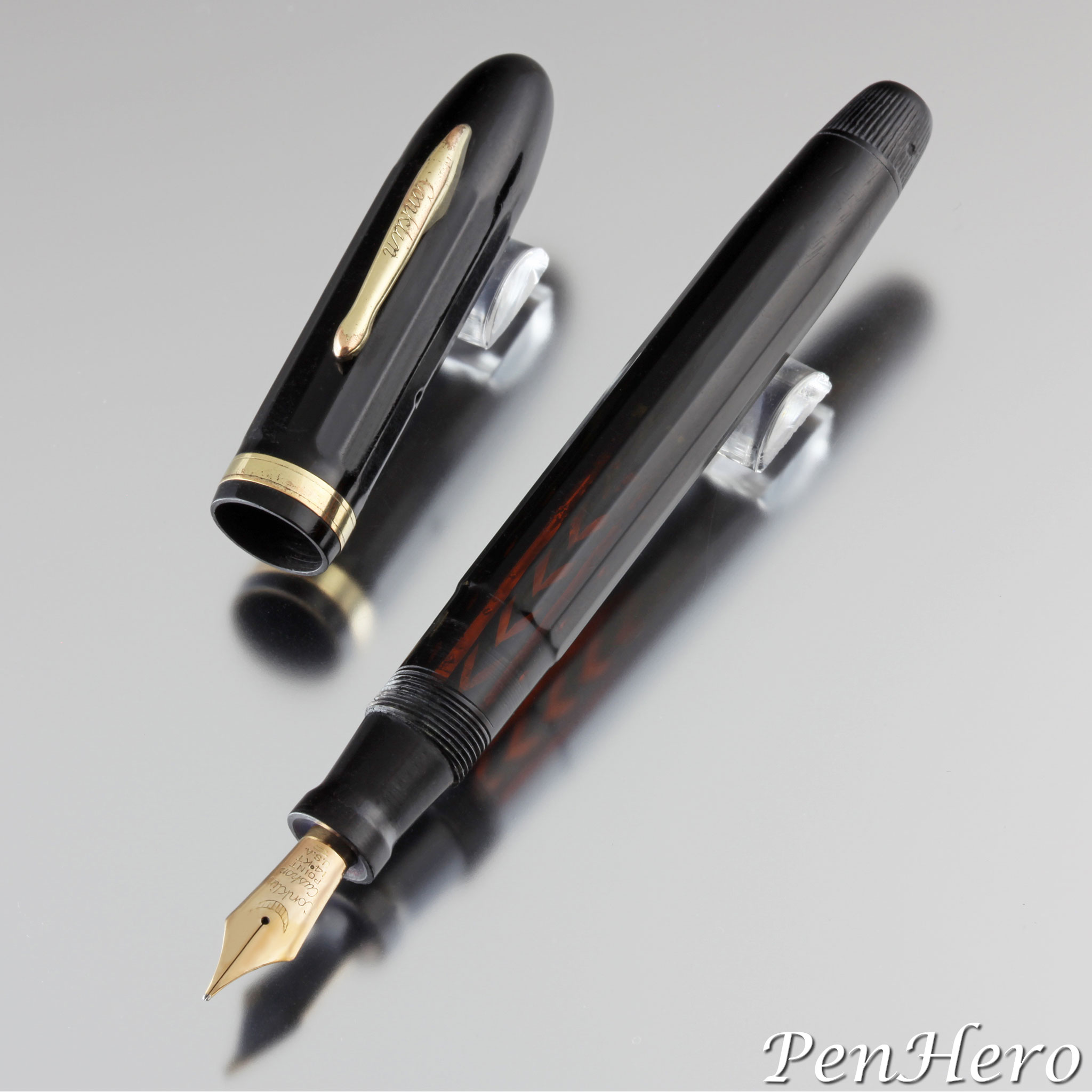 Conklin Nozac V-Line pen in Black c. 1937-38
Conklin Nozac V-Line pen in Black c. 1937-38
In my experience, Black V-Line Nozacs are the least common faceted pen and round V-Lines are less common than faceted pens. This isn’t necessarily reflected in valuation as the large size faceted pens tend to command the highest prices.
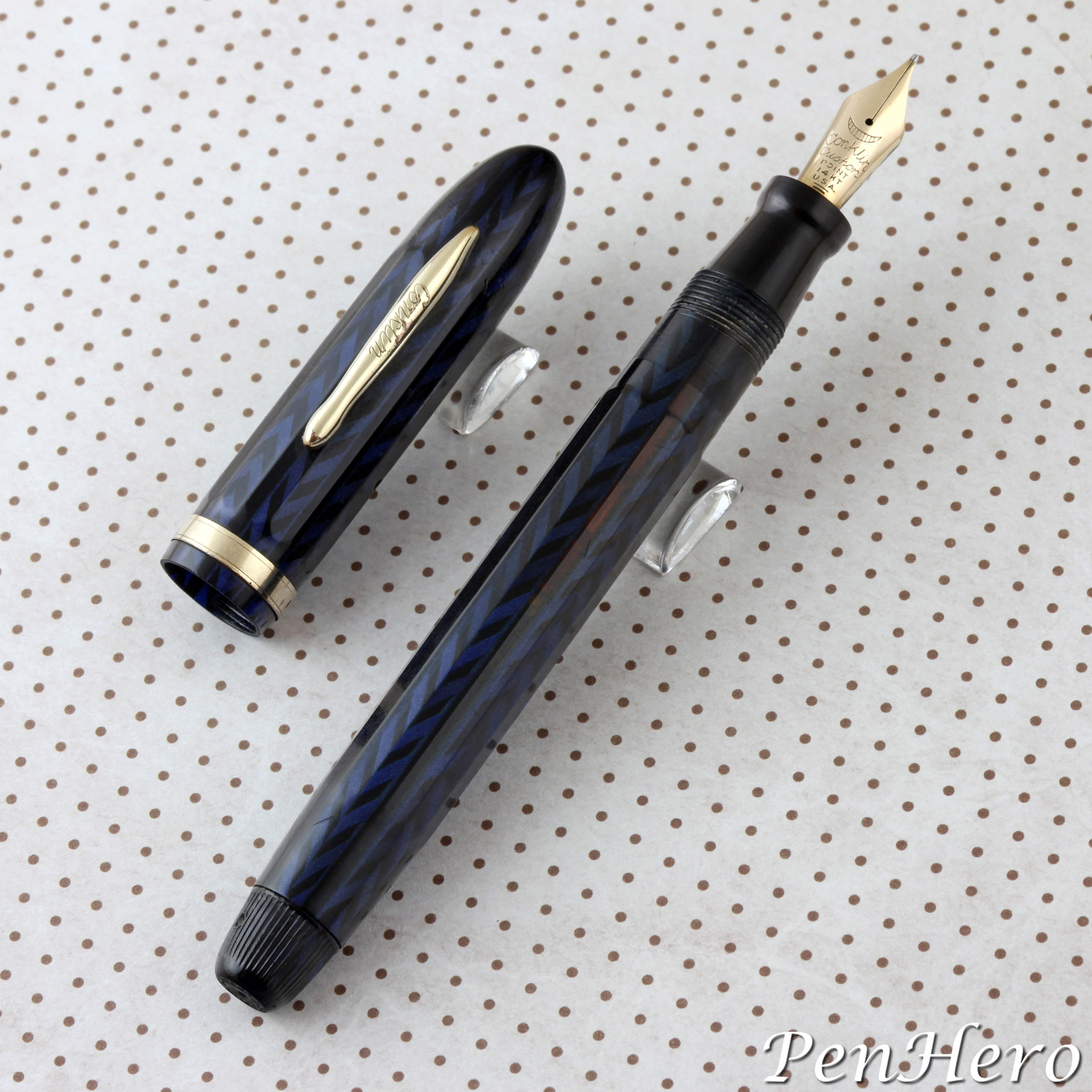 Conklin Nozac V-Line pen in Royal Blue c. 1937-38
Conklin Nozac V-Line pen in Royal Blue c. 1937-38
Restoring Conklin Nozacs is an advanced repair and requires expertise and a fully restored pen will be considerably more expensive than the same pen unrestored. Beware that some non-working piston fillers may not be restorable and would serve only as parts pens. Some key questions for an unrestored Nozac include barrel clarity, if the piston moves up and down easily, if there are any cracks in the cap lip or barrel, and if the clip opens and closes tightly. When in doubt, ask an experienced Conklin Nozac repair person.
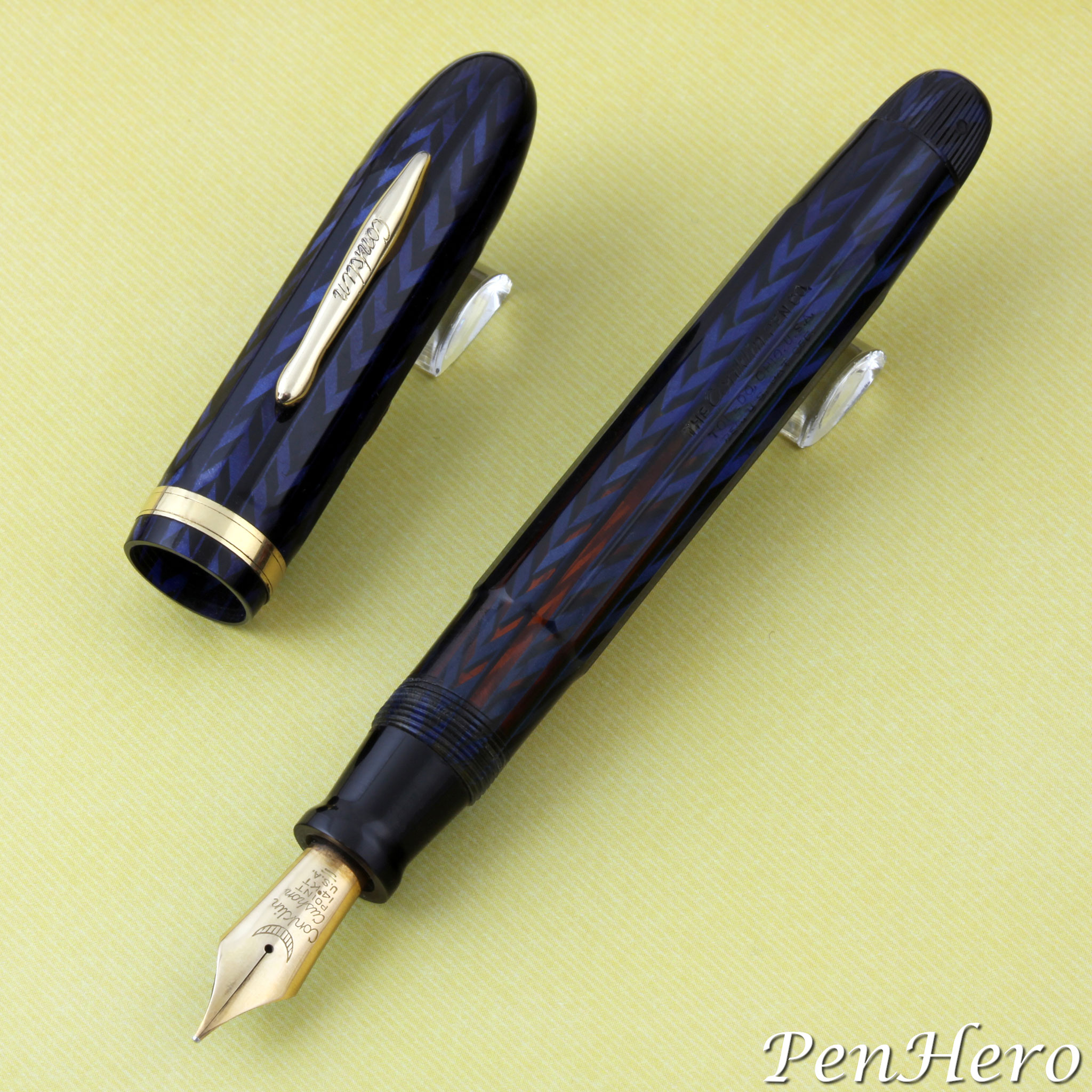 Conklin Nozac V-Line pen in Royal Blue c. 1937-38
Conklin Nozac V-Line pen in Royal Blue c. 1937-38
As I have said in my other Nozac articles, in spite of the potential risks, a restored, well adjusted Nozac can be a great writer and a highlight to a collection. They hold a lot of ink and the faceted pens feel great in the hand. If your budget is limited, try to find a restored user grade pen and have fun with it!
Acknowledgements
Many thanks Pete Kirby and Dave Glass for their invaluable help on facts and history of Conklin Nozacs.
Pennant Fall 2018
This story appeared in the fall 2018 Pennant, the magazine of the Pen Collectors of America (PCA). You can learn more about joining the PCA and subscribing to the Pennant by clicking the link.
References
Cincinnati Enquirer, March 9, 1937, page 2
Cincinnati Enquirer, July 14, 1938, page 16
Conklin 1937 Catalog
Collier’s, December 1937, , page XX
New York Daily News, December 1, 1937, page 9
New York Daily News, June 15, 1938, page 9
Saturday Evening Post, September 11, 1937, page XX
St. Louis Post Dispatch, February 20, 1937, page 2A
U.S. Design Patent No. D096892 awarded September 17, 1935 to Andreas Bienenstein
U.S. Design Patent No. D096890 awarded September 17, 1935 to Andreas Bienenstein
Interact
Comments on this article may be sent to the author, Jim Mamoulides


